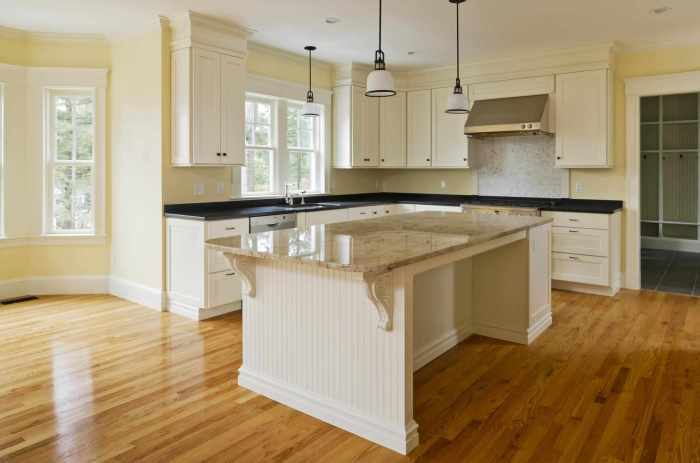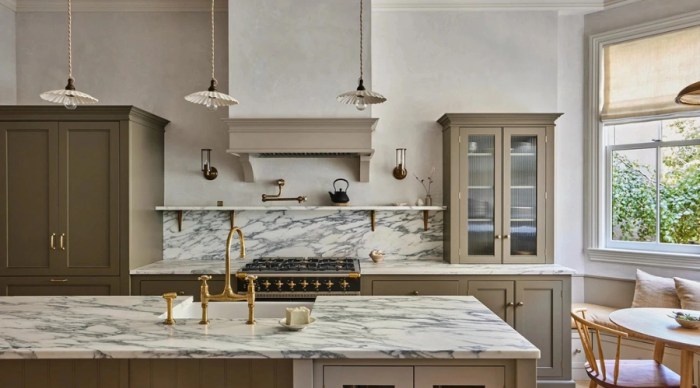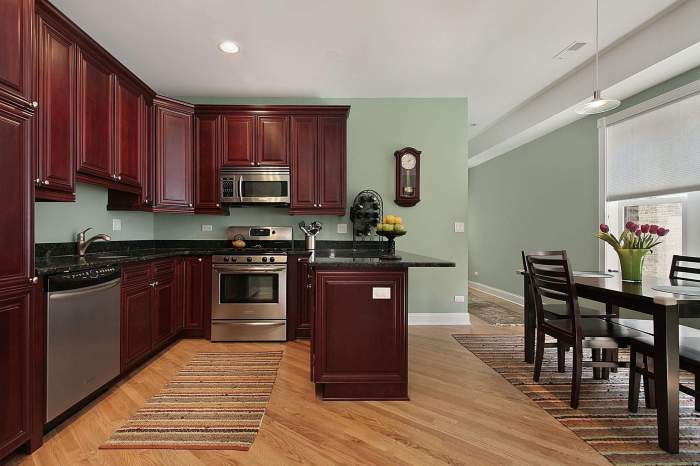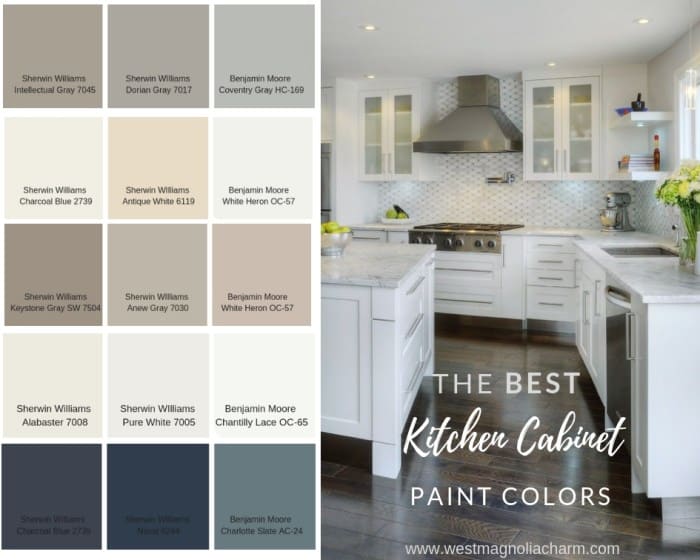The kitchen, the heart of the home, deserves a color palette that reflects both functionality and style. Subtle classic kitchen wall paint colors offer a sophisticated approach, transcending fleeting trends to create a timeless and inviting atmosphere. This exploration delves into the science of color psychology as it applies to kitchen design, examining how specific hues influence mood, appetite, and the perceived spatial dimensions of the room.
We’ll explore the interplay of light and shadow, warm and cool tones, and how these elements combine to create a truly harmonious culinary haven.
From understanding the nuances of color undertones and their impact on overall ambiance to mastering the art of color coordination with countertops, cabinetry, and flooring, this guide provides a comprehensive framework for selecting the perfect subtle classic paint color for your unique kitchen style. We will analyze the practical considerations, such as lighting conditions and existing architectural features, to ensure your chosen color enhances rather than detracts from the space.
Through illustrative examples and a step-by-step approach, we will empower you to transform your kitchen into a space that is both aesthetically pleasing and emotionally resonant.
Defining “Subtle Classic Kitchen Wall Paint Colors”

The term “subtle classic kitchen wall paint colors” refers to a palette of hues that evoke a sense of timeless elegance without being overly bold or trendy. These colors are characterized by their understated sophistication, creating a backdrop that complements various styles and design elements while maintaining a sense of calm and order. They stand apart from more vibrant or intensely saturated palettes by their muted tones and ability to create a feeling of spaciousness and tranquility.
Subtle classic colors are carefully selected to avoid jarring contrasts or overwhelming visual stimulation. Their neutrality allows the other elements within the kitchen—cabinetry, countertops, backsplash—to take center stage without competition. This approach prioritizes balance and harmony, creating a space that is both visually appealing and functionally comfortable.
Color Families Associated with Subtle Classic Kitchen Aesthetics
Subtle classic kitchen aesthetics draw heavily from a range of color families, each offering unique nuances and visual effects. These families share a common thread of muted tones and understated elegance, allowing for versatile design choices. The most commonly employed families include neutrals, pastels, and soft jewel tones. Neutrals, such as creams, greiges (a blend of gray and beige), and soft whites, offer a blank canvas, allowing for maximum flexibility in accessorizing.
Pastels, including muted blues, greens, and pinks, inject a gentle touch of color without overwhelming the space. Finally, soft jewel tones, like dusty rose or muted sage green, provide a sophisticated depth while retaining a calm atmosphere.
Comparison of Cool and Warm Subtle Classic Kitchen Colors
The choice between cool and warm subtle classic colors significantly impacts the overall mood and feel of the kitchen. Cool colors tend to create a sense of spaciousness and serenity, while warm colors foster a feeling of coziness and intimacy. Understanding the undertones of each color is crucial for achieving the desired effect.
| Color | Undertones | Mood | Example |
|---|---|---|---|
| Soft White | Slightly cool, possibly with gray or blue undertones | Clean, airy, spacious | Imagine a crisp, bright white subtly softened with a hint of gray, evoking a clean, minimalist feel. |
| Greige | Balanced, with equal parts gray and beige | Neutral, calming, versatile | Visualize a color that sits perfectly between gray and beige, creating a sophisticated and adaptable backdrop. |
| Pale Blue | Cool, possibly with gray or green undertones | Serene, calming, refreshing | Picture a light, airy blue reminiscent of a clear sky, imparting a sense of tranquility and openness. |
| Cream | Warm, possibly with yellow or beige undertones | Warm, inviting, comforting | Envision a rich, creamy hue with subtle yellow undertones, creating a welcoming and homely atmosphere. |
| Soft Green | Warm, possibly with yellow or olive undertones | Relaxing, natural, inviting | Imagine a muted sage green, suggesting the calmness of nature and a sense of tranquility. |
| Dusty Rose | Warm, possibly with brown or gray undertones | Romantic, sophisticated, calming | Picture a muted rose, a delicate shade with brown undertones creating a soft, elegant feel. |
Exploring Color Psychology in Subtle Classic Kitchens
The subtle classic kitchen, a haven of calm and functionality, is significantly influenced by the psychology of color. The carefully chosen hues on the walls don’t merely provide aesthetic appeal; they actively shape the perception of space, influence mood, and even affect appetite. Understanding the interplay between color and human psychology is crucial in designing a kitchen that is both visually pleasing and conducive to a positive culinary experience.
This exploration delves into the scientific understanding of how different subtle classic colors impact the kitchen environment.
Color Impact on Perceived Size and Ambiance
Color’s effect on spatial perception is well-documented. Lighter, cooler colors like soft blues and greens tend to visually expand a space, making a small kitchen feel more open and airy. This is because lighter colors reflect more light, creating a sense of depth. Conversely, darker, warmer colors such as muted grays or deep taupes can make a room feel smaller and more intimate, though they can also create a sense of coziness and sophistication.
In a small kitchen, strategic use of light colors on walls, combined with darker accents on cabinetry or flooring, can achieve a balance between spaciousness and visual interest. The perceived temperature of the kitchen is also influenced by color. Cool colors create a sense of coolness, while warm colors can make a space feel warmer. This is because our brains associate specific colors with specific temperatures.
Color’s Influence on Appetite and Mood
The relationship between color and appetite is a complex one, with research suggesting that different colors can stimulate or suppress appetite. Warm colors like yellows and oranges are often associated with energy and excitement, potentially stimulating appetite. However, overly saturated warm colors can also be overwhelming. Cooler colors, such as blues and greens, are generally associated with calmness and relaxation, which can sometimes suppress appetite, making them suitable for individuals aiming for mindful eating.
The mood created by the kitchen’s color scheme also plays a vital role in the overall culinary experience. Calming colors foster a relaxed atmosphere, ideal for leisurely cooking and dining, while more vibrant colors can inject energy and enthusiasm into the space.
Comparing Light and Dark Subtle Classic Colors
Light subtle classic colors, such as pale grays, soft creams, and muted pastels, create a sense of openness and brightness. They reflect light effectively, making the kitchen feel larger and more inviting. These colors generally promote a calm and serene atmosphere, conducive to relaxation and mindful cooking. In contrast, dark subtle classic colors, including charcoal grays, deep blues, and muted browns, create a more intimate and sophisticated ambiance.
They absorb light, making the space feel smaller and cozier. While they can add a touch of elegance, they might also feel oppressive in a poorly lit kitchen. The choice between light and dark depends heavily on the size and natural light levels of the kitchen.
Subtle Classic Colors and Associated Emotional Responses
The emotional impact of color is a significant factor in interior design. Careful selection can create a kitchen environment that supports the desired mood and function.
- Soft White/Cream: Evokes feelings of purity, cleanliness, and serenity. It is versatile and creates a bright, airy space.
- Pale Gray: Offers a sense of sophistication and calm, creating a neutral backdrop for other design elements.
- Muted Green: Inspires feelings of freshness, tranquility, and connection to nature.
- Soft Blue: Promotes relaxation and calmness, creating a peaceful and inviting atmosphere.
- Warm Beige: Creates a sense of warmth, comfort, and earthiness, promoting a feeling of security.
- Deep Taupe: Projects elegance and sophistication, creating a rich and luxurious feel.
- Muted Charcoal Gray: Offers a modern and sophisticated feel, adding a touch of drama and intensity.
Practical Application

Choosing the perfect subtle classic kitchen wall paint color is a nuanced process, blending aesthetics with practicality. The final result significantly impacts the overall mood and functionality of the space, demanding careful consideration of various factors. Understanding these factors and employing a systematic approach ensures a harmonious and visually appealing kitchen.The selection of a subtle classic kitchen paint color requires a holistic approach, considering the interplay of lighting, cabinetry, flooring, and countertop materials.
Ignoring any one of these elements can lead to a less-than-ideal outcome, potentially creating a clashing or unbalanced aesthetic. This section provides a structured guide to navigate these considerations and achieve a cohesive and pleasing design.
Factors Influencing Subtle Classic Kitchen Paint Color Selection
Lighting conditions significantly influence how a paint color appears. Natural light can make a color appear brighter and warmer, while artificial light can alter its hue and saturation. North-facing kitchens receive less direct sunlight, often appearing cooler, necessitating warmer paint tones. Conversely, south-facing kitchens, bathed in abundant sunlight, may benefit from cooler tones to prevent the space from feeling overly warm.
Cabinet styles also play a crucial role. Traditional cabinetry often pairs well with warmer, more saturated colors, while modern, minimalist cabinets might benefit from lighter, more neutral shades. Flooring should complement the wall color; light flooring pairs well with lighter wall colors, creating an airy feel, while darker flooring can balance lighter walls, adding depth and warmth.
Step-by-Step Guide for Selecting Subtle Classic Paint Colors
Selecting the perfect paint color involves a systematic process. Begin by assessing your kitchen’s style (farmhouse, modern, traditional). For farmhouse kitchens, consider creamy whites, soft greys, or muted greens—colors that evoke a sense of rustic charm. Modern kitchens often benefit from clean, crisp whites, light greys, or even subtle blues, reflecting the style’s minimalist aesthetic. Traditional kitchens can embrace warmer tones like beige, taupe, or soft yellows, creating a classic and inviting atmosphere.
Next, narrow down your color palette based on the factors discussed above (lighting, cabinetry, flooring). Finally, test paint swatches in different areas of the kitchen at various times of day to observe how the color changes with the lighting.
Effective Use of Color Swatches
Effective use of color swatches is critical for visualizing the final look. Apply the swatches to large pieces of white poster board, creating larger samples than the small paint chip. This allows for a more accurate representation of the color in the context of your kitchen. Place these larger samples on the walls in different locations and observe them under various lighting conditions – morning, midday, and evening.
Consider the reflection of light from the cabinets and flooring on the paint color. Take photos of the swatches in the kitchen to see how they look in different light, and compare them side-by-side.
Visual Guide: Subtle Classic Paint Colors and Countertop Materials
| Paint Color | Countertop Material | Description | Overall Impression |
|---|---|---|---|
| Soft White | Granite (Grey) | The soft white creates a bright and airy atmosphere, while the grey granite adds a sophisticated contrast. | Clean, modern, and elegant. |
| Warm Grey | Quartz (White) | The warm grey adds depth and warmth, complementing the clean white quartz. | Classic, timeless, and inviting. |
| Pale Green | Butcher Block | The pale green creates a fresh and calming atmosphere, complementing the natural wood tones of the butcher block. | Rustic, charming, and organic. |
| Creamy Beige | Granite (Brown) | The creamy beige creates a warm and inviting atmosphere, while the brown granite adds a touch of earthiness. | Traditional, sophisticated, and rich. |
Illustrative Examples of Subtle Classic Kitchen Wall Colors

Subtle classic kitchen wall colors create a foundation upon which the entire room’s design is built. The careful selection of a color, considering its undertones and the interplay with lighting, cabinetry, and flooring, significantly impacts the overall mood and atmosphere. The following examples demonstrate how different subtle classic colors achieve distinct yet harmonious kitchen designs.
Kitchen One: Warm Cream with Shaker Cabinets
This kitchen features walls painted in “Creamy Linen,” a warm, off-white with subtle beige undertones. The color, a shade akin to Benjamin Moore’s “White Dove,” but with a slightly richer hue, avoids starkness while providing a bright and welcoming backdrop. The natural light streaming through large windows enhances the cream’s warmth, creating a sense of spaciousness. The cabinetry is composed of classic Shaker-style units in a light, natural oak finish, complementing the wall color without competing.
The flooring is a medium-toned hardwood, providing a grounding element and introducing a hint of contrast. The overall style is comfortably traditional, with a touch of modern simplicity. The creamy linen walls diffuse the light, preventing harsh shadows and contributing to a feeling of calm and serenity. The subtle beige undertones add depth without overwhelming the space, creating a soft, inviting atmosphere perfect for both intimate gatherings and everyday family life.
Kitchen Two: Soft Gray with Modern Cabinets
In this kitchen, the walls are painted in “Silver Sage,” a soft gray with cool, green undertones reminiscent of Sherwin-Williams’ “Agreeable Gray.” This subtle shade offers a sophisticated neutrality that pairs well with contemporary elements. The kitchen boasts sleek, flat-panel cabinets in a crisp white, creating a clean and modern contrast against the calming gray walls. The flooring is a large-format porcelain tile in a light gray, echoing the wall color but adding a subtle textural difference.
Recessed lighting provides even illumination, preventing any sense of coldness often associated with gray. The cool green undertones in the “Silver Sage” prevent the gray from feeling sterile; instead, it fosters a tranquil and elegant ambiance. The overall style is modern and minimalist, with the wall color contributing to a feeling of calm efficiency and understated luxury.
Kitchen Three: Subdued Blue-Gray with Traditional Details
This kitchen showcases walls painted in “Misty Harbor,” a subdued blue-gray with hints of both blue and gray undertones. This color, similar in tone to Farrow & Ball’s “Cornforth White,” possesses a quiet elegance. The subtle blue undertones prevent it from feeling too cool, while the gray keeps it from becoming overly feminine. The kitchen features traditional cabinetry in a dark, stained wood finish, creating a beautiful contrast with the light walls.
The flooring is a patterned ceramic tile in muted earth tones, adding visual interest without distracting from the wall color. Ambient lighting, combined with strategically placed task lighting, illuminates the space evenly, highlighting the depth and subtle color variations within the “Misty Harbor” paint. The atmosphere created is one of refined sophistication and timeless charm. The subtle blue-gray walls provide a backdrop that is both calming and inviting, allowing the traditional details to shine while maintaining a sense of airy spaciousness.
Beyond the Walls

Extending the subtle elegance of classic kitchen wall colors requires a thoughtful approach to coordinating the entire space. The success of a cohesive and visually appealing kitchen hinges on understanding the interplay of color, texture, and material across all its elements, from the backsplash to the appliances and textiles. This holistic design strategy ensures that the subtle classic palette doesn’t feel isolated but instead acts as a harmonious foundation for the rest of the kitchen’s aesthetic.The principles of color harmony and contrast are paramount in achieving a visually balanced and pleasing kitchen.
Harmony creates a sense of unity and tranquility, while strategic contrast adds visual interest and prevents monotony. Understanding the color wheel and employing analogous (colors next to each other) or complementary (colors opposite each other) color schemes allows for a controlled and deliberate design approach, preventing accidental clashes and maximizing the impact of the chosen palette.
Color Coordination Strategies
Successful color coordination involves carefully selecting backsplashes, appliances, and textiles that either complement or subtly contrast with the chosen wall color. This requires consideration of both hue and saturation. For instance, a soft gray wall might pair beautifully with a white subway tile backsplash for a classic, clean look, or a warmer cream backsplash for a more traditional feel.
Stainless steel appliances offer a neutral counterpoint to virtually any subtle classic wall color, while colored appliances demand a more careful consideration of complementary hues. Similarly, textiles such as curtains, rugs, and chair cushions can introduce pops of color or reinforce the overall color scheme.
Illustrative Color Palettes
- Soft Gray Walls + White Subway Tile Backsplash + Stainless Steel Appliances + Natural Wood Cabinets: This palette offers a timeless and sophisticated aesthetic. The soft gray provides a calming backdrop, the white subway tile adds a touch of crispness, and the stainless steel appliances maintain a sleek, modern feel. Natural wood cabinets introduce warmth and texture, balancing the cool tones of the gray and white.
- Warm Cream Walls + Calacatta Gold Marble Backsplash + Brass Hardware + Dark Wood Cabinets: This palette exudes luxury and warmth. The cream walls create a soft, inviting atmosphere, while the Calacatta Gold marble backsplash adds a touch of elegance. Brass hardware complements the warmth of the cream and wood, creating a cohesive and opulent look. Dark wood cabinets provide a grounding element and contrast to the lighter walls and backsplash.
- Pale Blue-Gray Walls + White Shaker Cabinets + Light Gray Quartz Countertops + Black Appliances: This palette offers a fresh and modern feel. The pale blue-gray walls create a serene backdrop, the white shaker cabinets maintain a clean aesthetic, and the light gray quartz countertops provide a subtle contrast. Black appliances add a touch of sophistication and drama, creating a visually interesting contrast without overpowering the subtle palette.
Creating Visual Interest and Depth
Using varying textures and patterns can add significant visual interest without overwhelming the subtle classic color scheme. A smooth wall paint paired with a textured backsplash or patterned textiles introduces complexity and depth.
Strategic use of lighting can also enhance the subtle colors. Warm lighting can amplify the cozy feel of a cream-colored kitchen, while cooler lighting can highlight the crispness of a gray or blue-gray scheme.
Incorporating different shades of the same color family can create a sense of depth and sophistication. For example, using a slightly darker shade of gray for the lower cabinets or island can add visual weight and grounding to the space.
Last Recap
Ultimately, the selection of subtle classic kitchen wall paint colors is a journey of discovery, blending scientific understanding of color psychology with personal aesthetic preferences. By carefully considering factors like lighting, existing design elements, and the desired mood, homeowners can create a kitchen that is not just visually appealing but also emotionally enriching. The subtle elegance of a thoughtfully chosen color palette can transform a functional space into a sanctuary of calm and culinary creativity, a testament to the power of design and the enduring appeal of classic style.
The process, from initial color selection to the final brushstroke, becomes a rewarding experience, resulting in a kitchen that is uniquely yours—a space reflecting your personality and enhancing your daily life.
Essential FAQs
Can I use dark subtle classic colors in a small kitchen?
While dark colors can make a space feel smaller, strategically using them on one wall or with ample lighting can create a dramatic and intimate feel. Consider using lighter colors on other walls to balance the effect.
How do I choose a color that complements my existing countertops?
Consider the undertones of your countertops. Warm countertops (beige, cream) pair well with warm paint colors, while cool countertops (gray, white) complement cool paint shades. Test paint swatches against your countertops in natural light.
What is the best way to prepare my kitchen walls before painting?
Proper preparation is key. Clean the walls thoroughly, fill any holes or cracks, sand smooth, and prime the walls before applying paint for optimal adhesion and finish.
How long does subtle classic kitchen paint typically last?
The longevity depends on the paint quality and the amount of wear and tear. High-quality paints can last for several years, even in high-traffic areas. Regular cleaning will extend the life of the paint.
Are there any specific brands recommended for subtle classic kitchen paint?
Many reputable paint brands offer high-quality paints suitable for kitchens. Research brands known for their durability, washability, and color accuracy. Reading online reviews can be helpful in your decision-making process.